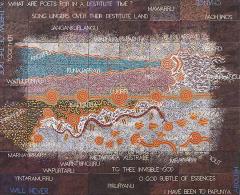
Central to this work Metafisica Australe and pivotal to the ongoing collaborative conversations between Tillers and Jagamara is the 1984 work Five Stories by Michael Nelson Jagamara.
Since Michael Nelson and Imants Tillers began working together in 2001, the context and subplot for much of their dialogue harks back to 1986 with an auspicious event involving as much chance and fate as it does artistic intent. In 1985 Imants Tillers took elements of Michael Nelson’s work (Five Stories 1984) in a new work entitled The Nine Shots. Coincidentally, these two images were illustrated side by side in a catalogue for the 1986 Sydney Biennale, provoking an uncommon reaction to such a fortuitous pairing. Although Tillers’s original motivation to use Jagamara’s imagery was largely an effort to highlight and celebrate indigenous art as part of a global art language, it was nevertheless done as a post-modernist gesture, without the artist’s permission. The subsequent debate that followed was to become the foundations for this remarkable story, and ultimately the catalyst for a collaborative series between these two important artists that has now stretched 16 years with 21 artworks.
Ian Maclean has recently commented in 2017:
“From its beginnings in the 1970s, Tillers’s appropriation art has been done in the spirit of conversations with other artists through engaging with their work, so there was a certain logic that the destiny of The Nine Shots would be collaborations with Jagamara.”
As Jagamara commented in 2014:
“I can put my design on top of his work- white man’s story- and my story on top of his…which is good to collaborate. I don’t mind Imants because he’s a good artist… and I’m a good artist. We both good artists!”
As Tillers recently said in 2017:
“If I didn’t make this mistake, then none of this work we have completed would have ever happened!”
Wally Caruana wrote with respect to the seminal work Five Stories in the London Sotheby’s catalogue, September 2016:
“Michael Jagamara Nelson’s painting Five Stories of 1984 is one of the iconic images of modern Aboriginal art. It has been published and exhibited widely, possibly more so than any other work by an Indigenous Australian artist. During the 1980s and 1990s Five Stories featured in several landmark exhibitions in Australia and abroad at a time when Aboriginal artists were breaking through the barriers that had consigned their art to the ethnographic domain to emerge as part of the discourse that is the world of contemporary art...
…In Five Stories, Michael Nelson Jagamara has introduced a number of pictorial innovations that distinguish the work from other, more conventional Western Desert acrylic paintings of the time. The graphic elements in the picture were outlined in yellow dots as opposed to the usual white to produce a scintillating visual effect akin to that of body painting in ceremony. In fact the black ground of the picture suggests black skin. The infill is constructed of dappled patches of colour as well as the usual arrays of dots. Yellow cloud-like forms contrast starkly against an even black ground in a triangular space in the lower left, reflected above in a blue wash covering the dotted field between the two meandering lines of possum tracks. In her monograph on Michael Nelson Jagamara, Vivien Johnson argues that such painterly devices render Five Stories ‘utterly original in relation to western [European] painting and the Papunya movement itself.’ ”…
In September 2016 the original work Five Stories, was sold at Sotheby’s London for AUD $687,877 (a record price for any living indigenous artist). For Jagamara this work had always been a magic carpet and it retains a provenance like no other Indigenous artwork. In 2008 Jagamara had painted a version for the collaborative work Fatherland. However, in March 2017, as if wanting to make the original appropriation by Tillers right, he took a leaf from Tillers’ own book, Jagamara ‘appropriated himself’ and painted a larger and highly detailed version of Five Stories on 36 canvas boards as the basis for this their latest collaboration. At this same time, Imants Tillers was preparing for his retrospective exhibition in Riga, Latvia (opening July 2018) with an accompanying documentary film. In April 2017 both Imants Tillers and the film crew went to Papunya to visit Jagamara at his home, viewing, exchanging and discussing the new Five Stories canvas boards. This definitive journey and symbolic meeting became the critical juncture for the making of Metafisica Australe.
Between April and July 2017, Tillers completed the work adding a further 36 boards, essentially to the four outer perimeters, thus amplifying many of the critical elements of Jagamara’s work. By retaining and extending Jagamara’s painted symbols and textures, the artists’ have allowed the original composition to echo louder, reverberating on another semantic platform - which shadows Tillers’ original motivations for the work in 1985.
Within Metafisica Australe, Jagamara’s Five Stories now sits within a communal, but uncompromised painterly landscape of spiritual enquiry. Jagamara’s original (visual) language securely resonates with texts and language including Warlpiri place names and dreaming sites; metaphysical and poetic references; and ultimately, a symbiosis of personal reflection in a shared (artists’) country…I have been to Papunya…
Michael Eather 2017
